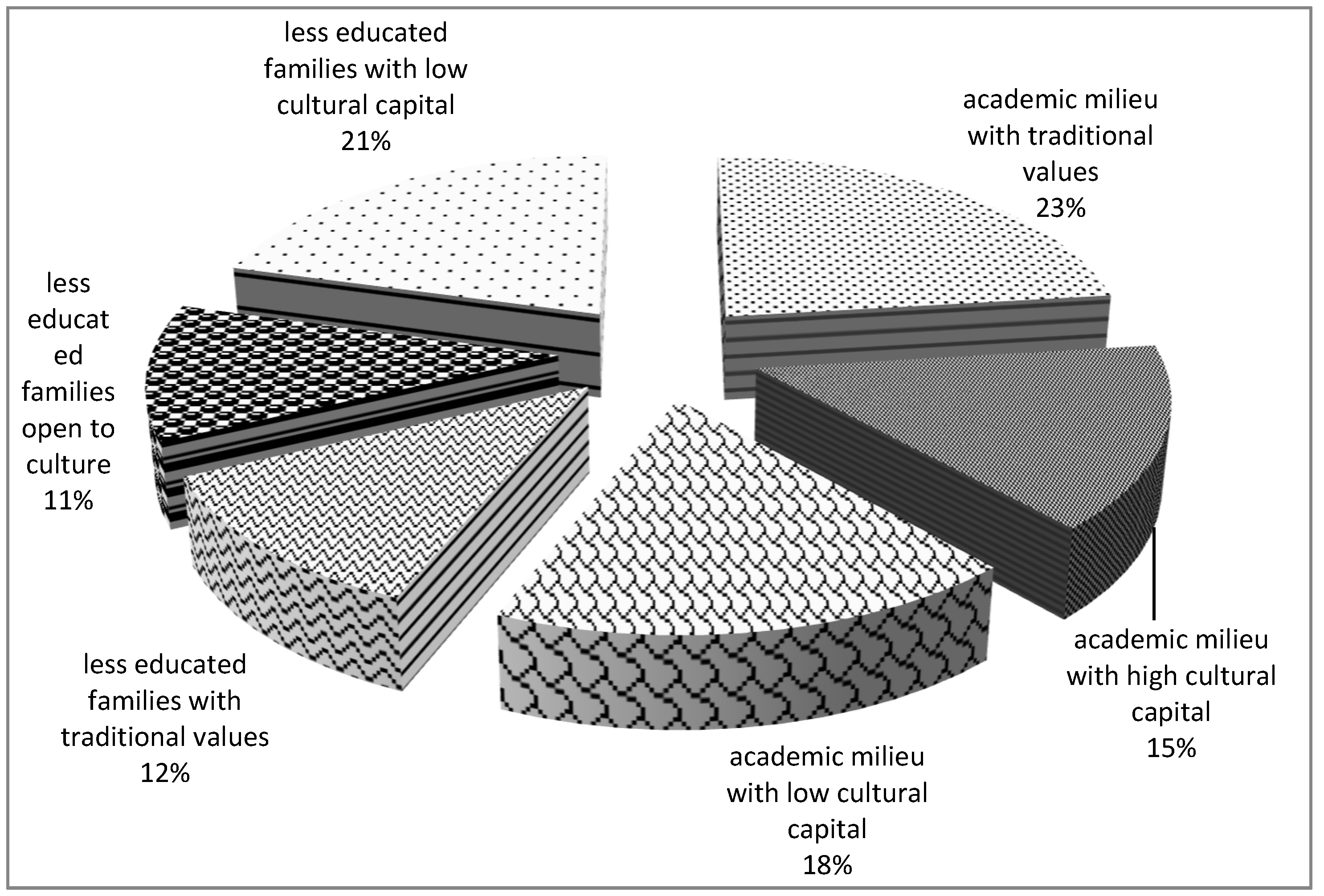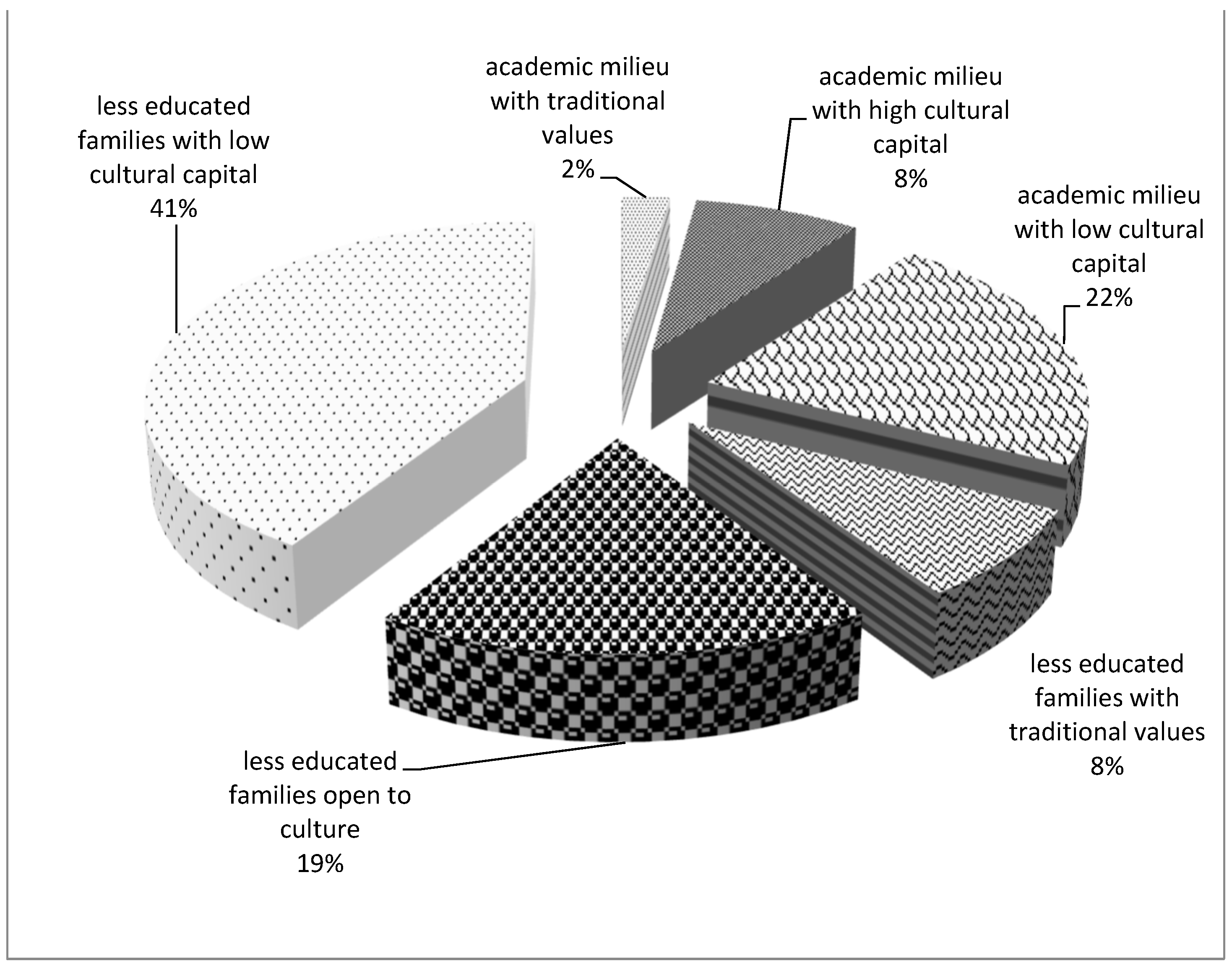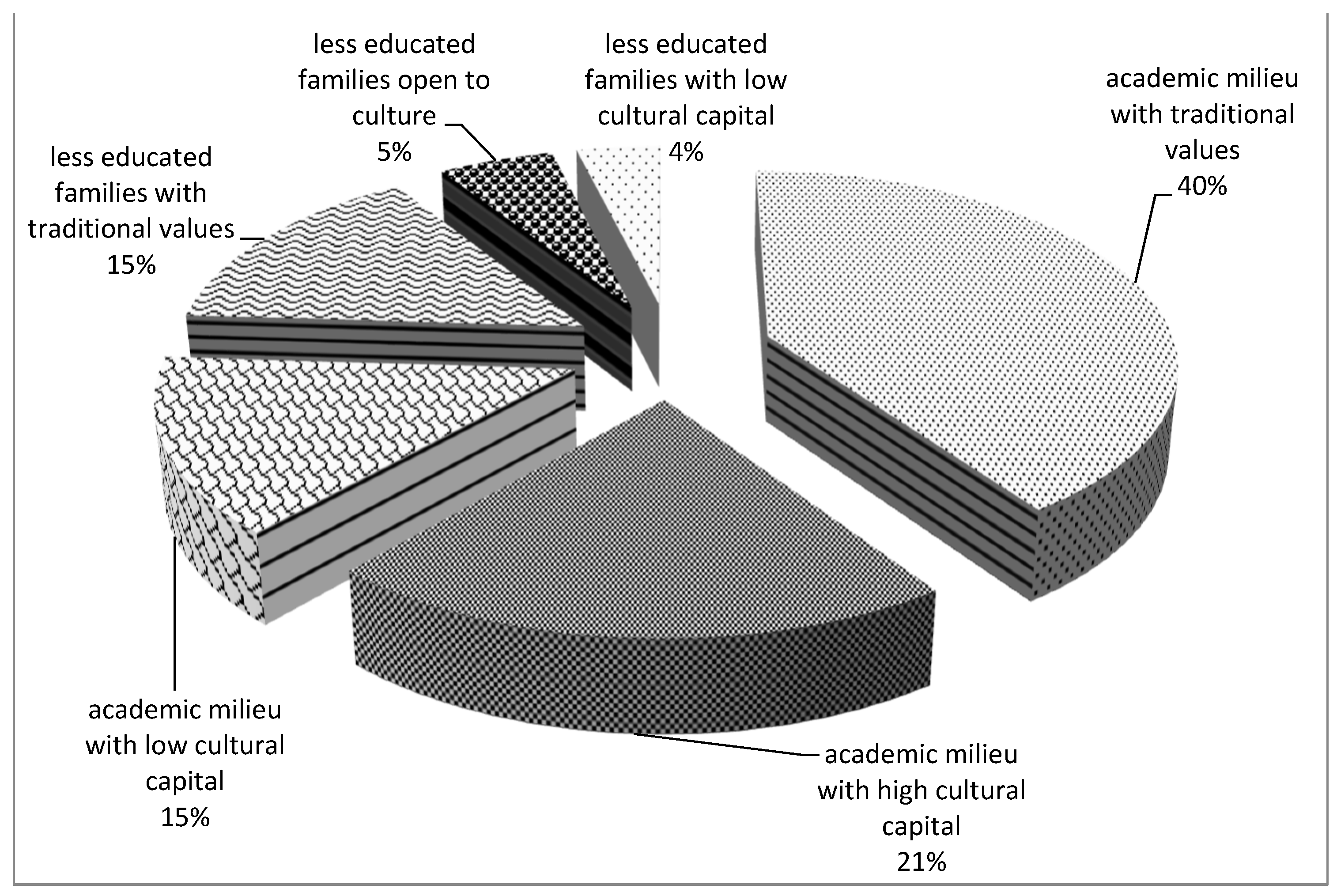The Relationship between Family Milieu and Music Education
Abstract
:1. Introduction
2. Literature Review
3. Methods
4. Results
5. Discussion
6. Conclusions
Funding
Institutional Review Board Statement
Informed Consent Statement
Data Availability Statement
Conflicts of Interest
| 1 | In Hungary, in elementary art education emphasis is placed on skill and personality development. The teaching material is a tool to improve students’ intellectual, emotional, and expressional skills. Improvement and knowledge enrichment is viewed as an instrument for personality formation. The task of elementary art schools is to maintain and development art skills, talents, and, if need be, to prepare students for profession-oriented further study. The training is available to any child who passes the basic audio and rythm drills (drills in the case of music art that require no prior preparation) at the entrance exam. Study takes place at elementary and further study class levels, for ages between 6 and 22. The interested children can choose from four branches of art–music, fine- and industrial arts, puppet- and performing arts, dance art. Maximum six hours a week are set aside for practicing the main subjects and acquiring the theoretical knowledge connected to them. Elementary art school is not obligatory, and students can only take advantage of services upon paying a fee. Students can only student free of charge at these institutes if they are cumulatively disadvantaged, simply disadvantaged, physically, sensory, intellectually handicapped and autistic (The CXC Act of 2011). |
| 2 | ISCED (International Standard Classification of Education) 1: elementary school, lower grade (1–4. osztály), ISCED 2 elementary school, upper grade (5–8. osztály), ISCED 3 high school (Forgács 2009). |
| 3 | Hungarian National Assessment of Basic Competences: “Since 2008 every student in the 6th, 8th and 10th years of their school education has had to complete competency test sheets and a background questionnaire revealing their socioeconomic status and attitudes towards learning. The assessment is similar to PISA in several respects, but it is limited to the assessment of reading comprehension and mathematics.” (Bacskai and Pándy 2017, p. 210). |
| 4 | To measure relative financial status, the respondant had to mark on a 10-point scale where they would place their family compared to other families. Based on the distribution of relative financial status and its peaks, we created three groups – below average (1–5), average (6), and above average (7–10)—which provided opportunity for further comparison. It is most definitely worth noting in connection iwth this variable that, on the one hand children struggle to judge their family’s monetary situation. This is a natural state to them, since they live in it daily, and do not see into the financial positions of other families—this makes the comparison a challenge. |
| 5 | During the examination of cultural consumption habits, we asked about the frequency of theater, cinema, museum, exhibition, classical music concert, folk music event, and library visitations. The “high culture consumers” library, theater, and music concerts are visited monthly, while the other events are frequented every three months. |
| 6 | David H. Demo (1992): Parent-Child Quality Time: Does Birth Order Matter? |
References
- Ainsworth, James William. 2002. Why does it take the Village? The Mediation of Neighborhood Effects on Educational Achievement. Social Forces 1: 117–52. [Google Scholar] [CrossRef]
- Andor, Mihály. 2002. Diplomás szülők gyermekei. [Children of degree-educated parents]. Educatio 2: 191–210. [Google Scholar]
- Angelusz, Róbert, Zoltán Fábián, and Róbert Tardos. 2006. Digitális egyenlőtlenségek és az infokommunikációs eszközhasználat válfajai. [Digital inequalities and the range of the usage of ICT devices]. In Társadalmi Riport 2004. Edited by Tamás Kolosi, István György Tóth and György Vukovich. Budapest: TÁRKI, pp. 309–31. [Google Scholar]
- Bácskai, Erika, Róbert Manchin, Mária Sági, and Iván Vitányi. 1972. Ének-zenei iskolába jártak [Students Who Went to Special Music Schools]. Budapest: Zeneműkiadó. [Google Scholar]
- Bacskai, Katinka, and Árpád Pándy. 2017. A denomination-based description of church-run primary schools—before and after the 2011 Expansion. Hungarian Educational Research Journal 5: 207–19. [Google Scholar]
- Bandura, Albert. 1989. Social Cognitive Theory. In Annals of Child Development. Vol. 6. Six Theories of Child Development. Edited by Ross Vasta. Greenwich: JAI Press, pp. 1–60. [Google Scholar]
- Becker, Gary Stanley. 1998. Preferenciák és értékek. In Tőkefajták: A társadalmi és kulturális erőforrások szociológiája. [Types of Capital: The Sociology of Social and Cultural Resources]. Edited by György Lengyel and Zoltán Szántó. Budapest: Aula Kiadó—Budapesti Közgazdaságtudományi Egyetem, pp. 101–29. [Google Scholar]
- Blaskó, Zsuzsa. 2002. Kulturális reprodukció vagy kulturális mobilitás. [Cultural reproduction or cultural mobility]. Szociológiai Szemle 2: 3–27. [Google Scholar]
- Boudon, Raymond. 1998. Társadalmi egyenlőtlenségek a továbbtanulásban. [Social inequalities in further studies]. In Oktatási rendszerek elmélete. Edited by Gábor Halász and Judit Lannert. Budapest: Okker Kiadó, pp. 406–17. [Google Scholar]
- Bourdieu, Pierre. 1978. A társadalmi egyenlőtlenségek újratermelődése. [Reproduction of social inequalities]. Budapest: Gondolat. [Google Scholar]
- Bourdieu, Pierre. 1986. Handbook of Theory and Research for the Sociology of Education. New York: Greenwood Press. [Google Scholar]
- Bourdieu, Pierre. 1999. Gazdasági tőke, kulturális tőke, társadalmi tőke. [Economic capital, cultural capital, social capital]. In A társadalmi rétegződés komponensei. Edited by Róbert Angelusz. Budapest: Új Mandátum, pp. 156–78. [Google Scholar]
- Bresler, Liora. 2002. Research: A foundation for arts education advocacy. In The New Handbook of Research on Music Teaching and Learning. Edited by Richard Colwell and Carol Richardson. New York: Oxford University Press, pp. 1066–83. [Google Scholar]
- Broh, Beckett Ann. 2002. Linking extracurricular programming to academic achievement: Who benefits and why? Sociology of Education 1: 69–95. [Google Scholar] [CrossRef]
- Catterall, James, Richard Chapleau, and John Iwanaga. 1999. Involvement in the arts and human development. In Champions of Change: The Impact of the Arts on Learning. Edited by Edward Fiske. Washington, DC: The Arts Education Partnership and the Presidents Committee on the Arts and the Humanit, pp. 1–18. [Google Scholar]
- Chin, Tiffani, and Meredith Phillips. 2004. Social reproduction and child-rearing practices: Social class, children’s agency, and the summer activity gap. Sociology od Education 3: 185–210. [Google Scholar] [CrossRef]
- Coleman, James Samuel. 1988. Social Capital in the Creation of the Human Capital. American Journal of Sociology 94: 95–120. [Google Scholar] [CrossRef]
- Coleman, James Samuel. 1990. Foundations of Social Theory. Cambridge: Harvard University Press. [Google Scholar]
- Custodero, Lori Almeida. 2002. Seeking Challenge, Finding Skill: Flow Experience and Music Education. Arts Education Policy Review 3: 3–9. [Google Scholar] [CrossRef]
- Demo, David H. 1992. Parent-Child Quality Time: Does Birth Order Matter? Journal of Marriage and Family 1: 104–17. [Google Scholar] [CrossRef]
- Dewey, John. 1915. The Psychology of Elementary Education. In The School and Society. Chicago: University of Chicago, pp. 87–108. [Google Scholar]
- DiMaggio, Paul Joseph. 1982. Cultural capital and school success: The impact of status culture participation on the grades of U.S. high school students. American Sociological Review 2: 189–201. [Google Scholar] [CrossRef]
- DiMaggio, Paul Joseph. 1998. A kulturális tőke és az iskolai teljesítmény: A státuskultúrában való részvétel hatása az Egyesült Államokbeli középiskolások jegyeire. [Cultural capital and school performance. The effect of participating in status culture on the school grades of secondary school students in the United States]. In A társadalmi mobilitás. Hagyományos és új megközelítések. [Social Mobility. Traditional and New Approaches]. Edited by Péter Róbert. Budapest: Új Mandátum, pp. 198–220. [Google Scholar]
- Dumais, Susan Alexandra. 2005a. Children’s Cultural Capital and Teachers’ Assessments of Effort and Ability: The Influence of School Sector. Journal of Catholic Education 4: 418–39. [Google Scholar] [CrossRef] [Green Version]
- Dumais, Susan Alexandra. 2005b. Early childhood cultural capital, parental habitus, and teachers’ perceptions. Poetics 2: 83–107. [Google Scholar] [CrossRef]
- Engler, Ágnes. 2010. A családi háttér szerepe a felsőfokú továbbtanulásban. [The role of social background in studying further in higher education]. Iskolakultúra 10: 28–38. [Google Scholar]
- Fend, Helmut. 1977. Schulklima: Sociale Einflussprozesse in der Schule. Weinheim and Basel: Beltz Verlag. [Google Scholar]
- Ferge, Zsuzsa. 1980. A társadalmi struktúra és az iskolarendszer közötti néhány összefüggés. [Some correlations between social structure and the school system]. In Társadalompolitikai tanulmányok. Edited by Csilla Meleg. Budapest: Gondolat, pp. 9–30. [Google Scholar]
- Forgács, András. 2009. ISCED—Az oktatás egységes nemzetközi osztályozási rendszere. [The Universal International Grading System of Education]. Available online: http://ofi.hu/isced-az-oktatas-egyseges-nemzetkozi-osztalyozasi-rendszere (accessed on 17 November 2022).
- Gick, Mary L. 2011. Singing, health and well-being: A health psychologist’s review. Psychomusicology: Music, Mind & Brain 1–2: 176–207. [Google Scholar]
- Granovetter, Mark. 1991. A gyenge kötések ereje. [The strength of weak ties]. In Társadalmunk rejtett hálózatai. Edited by Róbert Angelusz and Róbert Tardos. Budapest: Magyar Közvéleménykutató Intézet, pp. 371–403. [Google Scholar]
- Hanifan, Lyda Judson. 1916. The rural school and community center. Annals of the American Academy of Political and Social Science 1: 130–38. [Google Scholar] [CrossRef]
- Hargreaves, David J., Nigel A. Marshall, and Adrian C. North. 2003. Music education in the twenty-first century: A psychological perspective. British Journal of Music Education 2: 147–63. [Google Scholar] [CrossRef] [Green Version]
- Ho, Yim-Chi, Mei-Chun Cheung, and Agnes S. Chan. 2003. Music training improves verbal but not visual memory: Cross-sectional and longitudinal explorations in children. Neuropsychology 3: 439–50. [Google Scholar] [CrossRef] [Green Version]
- Hradil, Stefan. 1995. Régi fogalmak és új struktúrák. Miliő-, szubkultúra-, és életstílus-kutatás a ’80-as években. [Old concepts and new structures. Milieu, subculture and lifestyle studies in the 80s]. In Társadalmi rétegződés. Edited by Rudolf Andorka, Stefan Hradil and Jules L. Peschar. Budapest: Aula, pp. 347–90. [Google Scholar]
- Janurik, Márta. 2008. A zenei képességek szerepe az olvasás elsajátításában [The role of musical abilities in learning to read]. Magyar Pedagógia 4: 289–317. [Google Scholar]
- Janurik, Márta. 2020. A zenetanulás transzferhatásairól nemzetközi és hazai kutatások tükrében [On the transfer effects of music learning in the light of international and domestic research]. Valóság: Társadalomtudományi Közlöny 7: 77–94. [Google Scholar]
- Janurik, Márta, Noémi Kis, Norbert Szabó, and Krisztián Józsa. 2021. Az ének-zene tantárgy iránti attitűd összefüggése az iskolai zenetanulás iránti motivációval hetedik osztályos tanulók körében. [The correlation between the attitude toward the subject of music and the motivation to learn music in school among seventh graders]. Neveléstudomány 2: 18–42. [Google Scholar]
- Kaushal, Neeraj, Katherine Magnuson, and Jane Waldfogel. 2011. How is family income related to investments in children’s learning? In Whither Opportunity?: Rising Inequality, Schools, and Children’s Life Chances. Edited by Greg G. Duncan and Richard J. Murnane. New York: Russell Sage Foundation, pp. 187–206. [Google Scholar]
- Kennedy, Mary Ann. 2002. ‘It’s cool because we like to sing:’ Junior High School Boys’ Experience of Choral Music as an Elective. Research Studies in Music Education 1: 26–36. [Google Scholar] [CrossRef] [Green Version]
- Kovács, Klára. 2014. A sportolás mint támogató faktor a felsőoktatásban. A sportolási szokások hatásai magyarországi és romániai hallgatók körében. [Sport as a Supporting Factor in Higher Education. The Effect of Sport Habits among Hungarian and Romanian Higher Education Students]. Ph.D. dissertation, Debreceni Egyetem BTK Nevelés- és Művelődéstudományi Intézet, Debrecen, Hungary. [Google Scholar]
- Kovács, Klára. 2016. Közép-kelet-európai hallgatók sportolásának szocio-kulturális jellemzői. [The Socio-Cultural Characteristics of Central-Eastern European Students’ Sporting Habits]. In Értékteremtőtestnevelés. Tanulmányok a testnevelés és a sportolás szerepéről a Kárpát-medencei fiatalok életében. Oktatáskutatás a 21. században 1. Edited by Klára Kovács. Debrecen: Debreceni Egyetemi Kiadó, CHERD-H, pp. 175–86. [Google Scholar]
- Kozéki, Béla. 1991. Az iskola szelleme és nevelési céljai egy összehasonlító vizsgálat tükrében. [The spirit of school and its education goals in the light of a comparative study]. Magyar Pedagógia 1: 63–77. [Google Scholar]
- Kremer-Sadlik, Tamar, Carolina Izquierdo, and Marilena Fatigante. 2010. Making meaning of everyday practices: Parents’ attitudes toward children’s extracurricular activities in the United States and in Italy. Anthropology & Education Quarterly 1: 35–54. [Google Scholar]
- McNeal, Ralph B., Jr. 1999. Parental Involvement as Social Capital: Differential Effectiviness on Science Achivement, Truancy and Dropping Out. Social Forces 1: 117–44. [Google Scholar] [CrossRef]
- Meier, Ann. 1999. Social Capital and School Achievement among Adolescents CDE Working Paper 1–53. Available online: http://www.ssc.wisc.edu/cde/cdewp/99-18.pdf (accessed on 17 November 2022).
- Miksza, Peter. 2007. Music Participation and Socioeconomic Status as Correlates of Change: A Longitudinal Analysis of Academic Achievement. Bulletin of the Council for Research in Music Education 172: 41–58. [Google Scholar]
- Mollenhauer, Karl. 1974. Szocializáció és iskolai eredmény. [Socialization and school performance]. In Az iskola szociológiai problémái. [The Sociological Problems of the School]. Edited by Zsuzsa Ferge and Judit Háber. Budapest: Közgazdasági és Jogi Könyvkiadó, pp. 189–216. [Google Scholar]
- Orbán, Annamária, and Zoltán Szántó. 2005. Társadalmi tőke. [Social capital]. Erdélyi Társadalom 2: 55–70. [Google Scholar] [CrossRef]
- Portowitz, Adena, Osnat Lichtenstein, Ludmula Egorova, and Eva Brand. 2009. Underlying mechanisms linking music education and cognitive modifiability. Research Studies in Music Education 2: 107–28. [Google Scholar] [CrossRef]
- Pribesh, Shana L., Jane Smith Carson, Mikaela J. Dufur, Yuanyuan Yue, and Kathy Morgan. 2020. Family Structure Stability and Transitions, Parental Involvement, and Educational Outcomes. Social Sciences 12: 229. [Google Scholar] [CrossRef]
- Pusztai, Gabriella. 2004. Kapcsolat a jövő felé. Közösségi erőforrások szerepe roma/cigány diplomások iskolai pályafutásának alakulásában. [Relationship towards the future. The role of community resources in the development of the school career of Roma/Gypsy graduates]. Valóság 5: 69–84. [Google Scholar]
- Pusztai, Gabriella. 2009. A társadalmi tőke és az iskola. Kapcsolati erőforrások hatása az iskolai pályafutásra. [Social Capital and the School. The Effect of Relationship Resources on School Performance]. Budapest: Új Mandátum Könyvkiadó. [Google Scholar]
- Pusztai, Gabriella. 2015. Pathways to Success in Higher Education. Frankfurt am Main: Peter Lang Verlag. [Google Scholar]
- Putnam, Robert David. 1993. A prosperáló közösség. A társadalmi tőke és a közélet. [The prospering community. Social capital and public life]. Civil Ethosz 2: 11–17. [Google Scholar]
- Putnam, Robert David. 1995. Bowling Alone: America’s Declining Social Capital. Journal of Democracy 1: 65–78. [Google Scholar] [CrossRef] [Green Version]
- Reeves, Aaron. 2015. ‘Music’s a family thing’: Cultural socialisation and parental transference. Cultural Sociology 4: 493–514. [Google Scholar] [CrossRef]
- Róbert, Péter. 1987. Mobilitási és reprodukciós folyamatok a magyar társadalomban. [Mobility and reproduction processes in the Hungarian society]. In Magyarország társadalomtörténete. Edited by Nikosz Fokasz and Antal Örkény. Budapest: Új Mandátum, pp. 193–206. [Google Scholar]
- Schellenberg, E. Glenn. 2004. Music lessons enhance IQ. Psychological Science 8: 511–14. [Google Scholar] [CrossRef] [PubMed]
- Schmithorst, Vincent J., and Scott K. Holland. 2004. The effect of musical training on the neural correlates of math processing: A functional magnetic resonance imaging study in humans. Neuroscience Letters 3: 193–96. [Google Scholar] [CrossRef] [PubMed]
- Sichivitsa, Veronica O. 2007. The influences of parents, teachers, peers and other factors on students’ motivation in music. Research Studies in Music Education 1: 55–68. [Google Scholar] [CrossRef]
- Szűcs, Tímea. 2019. Az alapfokú művészeti iskola, egy esélynövelő iskolatípus. [Elementary Art School, a Type of School Enhancing Opportunities]. Debrecen: Debreceni Egyetemi Kiadó. [Google Scholar]
- Szűcs, Tímea, Henrietta Kelemen, Zsófia Miklódi-Simon, and Judit Váradi. 2022. A szülők szerepe gyermekük művészeti nevelésében. A szülői bevonódás hatása a transzgenerációs folyamatban. [The roles of parents in their child’s arts education. The effect of parental inclusion in the transgenerational process]. In Értékközvetítés és iskola. Tanulmányok Szabó László Tamás tiszteletére. Edited by Klára Kovács. Debrecen: Debrecen-CHERD, pp. 54–71. [Google Scholar]
- The CXC Act of 2011. évi CXC. törvény a nemzeti köznevelésről. [The CXC National Public Education Act of 2011]. Budapest: Wolters Kluwer Hungary Kft.
- Vincent, Carol, and Stephen Ball. 2007. ‘Making Up’ the Middle-Class Child: Families, Activities and Class Dispositions. Sociology 6: 1061–77. [Google Scholar] [CrossRef]
- Wen, Ming, Weidong Wang, Neng Wan, and Dejun Su. 2020. Family Income and Student Educational and Cognitive Outcomes in China: Exploring the Material and Psychosocial Mechanisms. Social Sciences 12: 225. [Google Scholar] [CrossRef]
- Wong, Patrick C. M., and Tyler Perrachione. 2007. Learning pitch patterns in lexical identification by native English-speaking adults. Applied Psycholinguistics 4: 565–85. [Google Scholar] [CrossRef]



| Parents’ music education biography | Formal music education | Childhood music school studies |
| The current musical activity of parents |
| |
| Children’s music education biography | Formal music education | Elementary art school |
| Parental participation in child’s musical education |
|
| Sig. | Exp (B) | ||
|---|---|---|---|
| Economic capital | objective financial situation | 0.017 | 2.214 |
| relative financial situation | 0.005 | 0.254 | |
| Social capital | religion | 0.008 | 2.418 |
| family composition | 0.048 | 2.157 | |
| number of siblings | 0.587 | 1.203 | |
| Institutionalized cultural capital | mother with a higher education degree | 0.001 | 3.48 |
| father with a higher education degree | 0.129 | 1.839 | |
| Objectified cultural capital | size of the family library | 0.003 | 4.275 |
| Incorporated cultural capital | singing at home | 0.029 | 2.23 |
| playing music at home | 0.377 | 1.444 | |
| cultural consumption habits | 0.000 | 10.658 |
Publisher’s Note: MDPI stays neutral with regard to jurisdictional claims in published maps and institutional affiliations. |
© 2022 by the author. Licensee MDPI, Basel, Switzerland. This article is an open access article distributed under the terms and conditions of the Creative Commons Attribution (CC BY) license (https://creativecommons.org/licenses/by/4.0/).
Share and Cite
Szűcs, T. The Relationship between Family Milieu and Music Education. Soc. Sci. 2022, 11, 579. https://doi.org/10.3390/socsci11120579
Szűcs T. The Relationship between Family Milieu and Music Education. Social Sciences. 2022; 11(12):579. https://doi.org/10.3390/socsci11120579
Chicago/Turabian StyleSzűcs, Tímea. 2022. "The Relationship between Family Milieu and Music Education" Social Sciences 11, no. 12: 579. https://doi.org/10.3390/socsci11120579
APA StyleSzűcs, T. (2022). The Relationship between Family Milieu and Music Education. Social Sciences, 11(12), 579. https://doi.org/10.3390/socsci11120579





